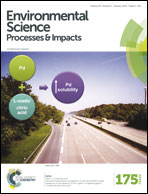Spatial and temporal distributions of 134Cs and 137Cs derived from the TEPCO Fukushima Daiichi Nuclear Power Plant accident in the North Pacific Ocean by using optimal interpolation analysis†
Abstract
Optimal interpolation (OI) analysis was used to investigate the oceanic distributions of 134Cs and 137Cs released from the Tokyo Electric Power Company Fukushima Daiichi Nuclear Power Plant (FNPP1) accident. From the end of March to early April 2011, extremely high activities were observed in the coastal surface seawater near the FNPP1. The high activities spread to a region near 165°E in the western North Pacific Ocean, with a latitudinal center of 40°N. Atmospheric deposition also caused high activities in the region between 180° and 130°W in the North Pacific Ocean. The inventory of FNPP1-released 134Cs in the North Pacific Ocean was estimated to be 15.3 ± 2.6 PBq. About half of this activity (8.4 ± 2.6 PBq) was found in the coastal region near the FNPP1. After 6 April 2011, when major direct releases ceased, the FNPP1-released 134Cs in the coastal region decreased exponentially with an apparent half-time of about 4.2 ± 0.5 days and declined to about 2 ± 0.4 PBq by the middle of May 2011. Taking into account that the 134Cs/137Cs activity ratio was about 1 just after release and was extremely uniform during the first month after the accident, the amount of 137Cs released by the FNPP1 accident increased the North Pacific inventory of 137Cs due to bomb testing during the 1950s and early 1960s by 20%.


 Please wait while we load your content...
Please wait while we load your content...